Jacob Binder, 1818 - 1893
“J. B.” (USA)
by Brian Stevenson
last updated March, 2018
Jacob Binder was deeply involved in the scientific community of late nineteenth century Philadelphia. He joined the Academy of Natural Sciences of Philadelphia in 1879. He then served in a number of offices, most significantly as Curator of the William S. Vaux collection of minerals. He was also a preparer of good-quality microscope slides, many of which bear labels printed with his name (Figures 1 and 2).
Microscope slides are seen with some frequency that bear labels with a monogram “J B” (Figures 1 and 3). These are very different from the “J B”-monogrammed slides that were produced in London during the mid- to late-1800s by John Barnett (1816 - 1882), and there are no reasons to assume a connection. The “J B” slides under consideration are often seen being sold in collections that originated from the Philadelphia, USA region. The handwriting on such slides is very similar to that on Binder’s productions. The manners of finish are also very similar. The labels printed with the “J B” monogram share many features with those used by Benjamin F. and Gertrude A. Quimby on their monogrammed slide labels (Figure 3). The Quimby’s were also members of the Philadelphia scientific and microscopic communities. Taken together, it is highly likely that Jacob Binder was the American slide-maker who used the “J B” monogram.
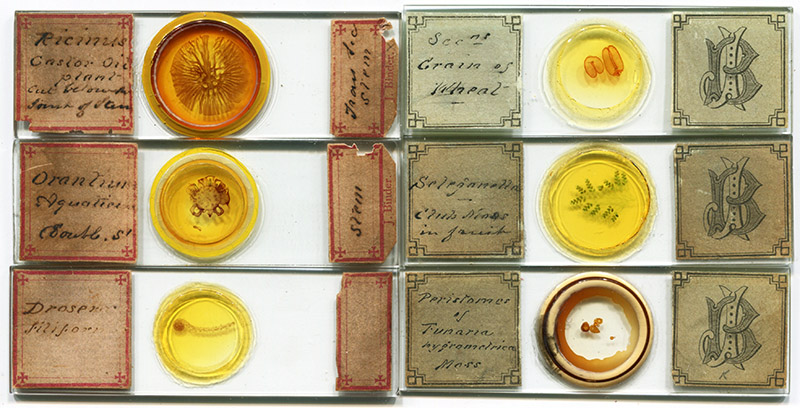
Figure 1.
Left: two microscope slides with labels printed “J. Binder”, and a third with the same handwriting and identical labels, except that the smaller label is missing Binder’s name. Right: Slides with handwriting that strongly resembles that on the J. Binder slides, with additional labels that bear the monogram “J B”. All of these slides have provenance of originating in Philadelphia, Pennsylvania, USA.
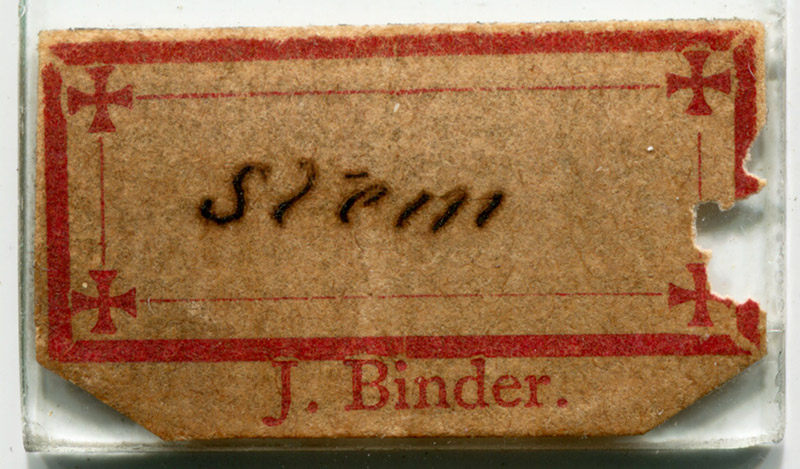
Figure 2.
Enlargement of Binder’s name on a slide label.
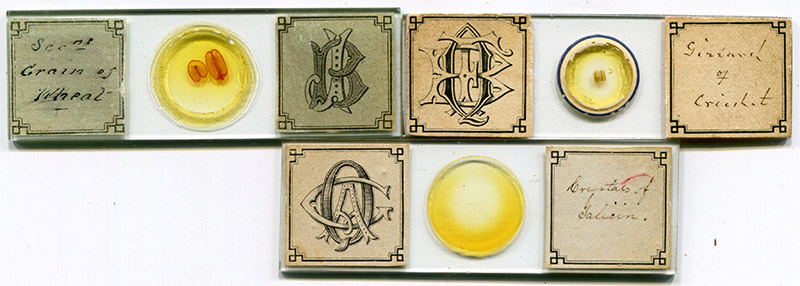
Figure 3.
Further evidence connecting Jacob Binder to the American “J B” slides: comparison with slides that were made by Philadelphia microscopists Benjamin F. and Gertrude A. Quimby strongly suggest that all of these monogrammed papers were produced by the same printer. The Quimbys moved to Philadelphia in 1870 and, after a bitter divorce circa 1880, Benjamin moved to Chicago and Gertrude disappeared from records. Binder was also active in the Philadelphia microscopist circle at the same time as the Quimbys.
Jacob was born on August 27, 1819, in Philadelphia, the eldest child of William and Louisa Elizabeth Stam Binder. William was a hat maker.
Jacob became a lumber dealer and builder. The 1861 census listed his as being a “master carpenter”. The 1861 Philadelphia City Directory listed him as a “lumber dealer and builder”, in partnership with his brother George (the second son). They had a lumber yard and a moulding mill at the corner of 6th & Oxford Streets.
In 1842, Jacob married Mary Ann Fairman. They had six children, three of whom survived to adulthood. Mary Ann died in 1861. Jacob remarried in 1863, to Catharine Ann Royal, with whom he had another eight children, with seven surviving childhood.
Binder was elected to membership in the Academy of Natural Sciences in January, 1879. That same year he was elected to the Mineralogical and Geological Section’s Board of Curators, along with two other notable microscopists, Charles Zentmayer and J. Gibbons Hunt.
In 1883, he was appointed Curator of the Vaux mineral collection. William S. Vaux had been a member since 1834 and, upon his death in 1882, bequeathed to the Academy his collections of minerals and archaeological specimens, $1,000 to provide additional cases, and $10,000 for the care and increase of the collections. Binder declined financial compensation, and put his heart into the job. He attended courses on mineralogy at the University of Pennsylvania, which helped him to arrange the collection according to current systems.
Binder became a member of the Board of Trustees of the Building Fund in 1884. He also occasionally chaired meetings of the Academy.
Records of the Academy indicate that Binder frequently exhibited microscopic specimens and apparatus. At the 1880 the annual meeting of the Biological and Microscopical Section, he showed his “rotating table” (a circular table set on a spindle, such that a microscope could be set up with an object, then rotated around to be viewed by several people sitting around the table). There was extensive interest in his May 1, 1882 exhibition, “Mr. Jacob Binder, exhibited four specimens of the legs of beetles belonging to two genera of the Coleoptera, Dytiscus marginalis and Arcelius mediatis, from the Hammondton ponds of New Jersey, and Arcelius fraternus, a European species. These objects were intended to show the formation of the sucking-cups, found upon the forelegs of the different varieties. They are only upon the forelegs, except in the case of the Dytiscus marginalis, where they are also found upon the middle legs in a less developed condition. These suckers are sufficiently distinctive in their character to assist the entomologist in their classification. The function of these organs seems to be to facilitate the males in adhering to the female during sexual intercourse. Mr. Binder, called the attention of the members particularly to objects of this kind not that he claimed a new discovery, but because they are so easily obtained and requiring very little skill in their preparation. Microscopical specimens of rare beauty, interest, and instruction can be obtained. The suckers are not the only objects of interest to be found upon the beetles. By dissection, the spiracles and the branchial trachea of the respiratory apparatus can be shown, and when these objects are made sufficiently transparent, it is possible to show the tracheal tubes within the boring case of the legs surrounded by their delicate spiral covering”.
Binder’s health deteriorated severely as the 1890s began. The 1892 Annual Report of the Academy stated, “Mr. Jacob Binder was re-appointed Curator of the William S. Vaux collections. As Mr. Binder has been, during a portion of the year, unable in consequence of failing health to discharge the duties of the position, Mr. W.W. Jefferis was appointed as his associate. The growth of the collections under their charge is recorded in the special report prepared by Mr. Jefferis”.
He died on February 26, 1893. The Academy’s Proceedings reported, “Mr. Jacob Binder, who had served the society as Curator of the William S. Vaux collections since their reception by the Academy, died after a lingering illness February 26th”, and “The Academy having heard with sincere regret of the death, the 26th inst., of Mr. Jacob Binder, the Curator of the William A. Vaux Collections, it is fitting that a record be made of the society's appreciation of the loss which it has thereby sustained. During the latter years of Mr. Binder's life, from his election to membership in January 1879 until incapacitated by the lingering illness which has just terminated fatally, his best energies have been devoted to furthering the interests of the Academy. He performed his duties as Curator from January 1883 to January 1892, as member of the Board of Trustees of the Building Fund from January 1884 to February 1890 and as Curator of the William S. Vaux Collections since 1883, with energy, discretion and liberality. His knowledge of business details was of the utmost value in the financial administration of the society, while his personal qualities were such as to endear him to his associates. The Academy desires to convey to Mr. Binder's wife and children the assurance of its profound sympathy in their bereavement”.
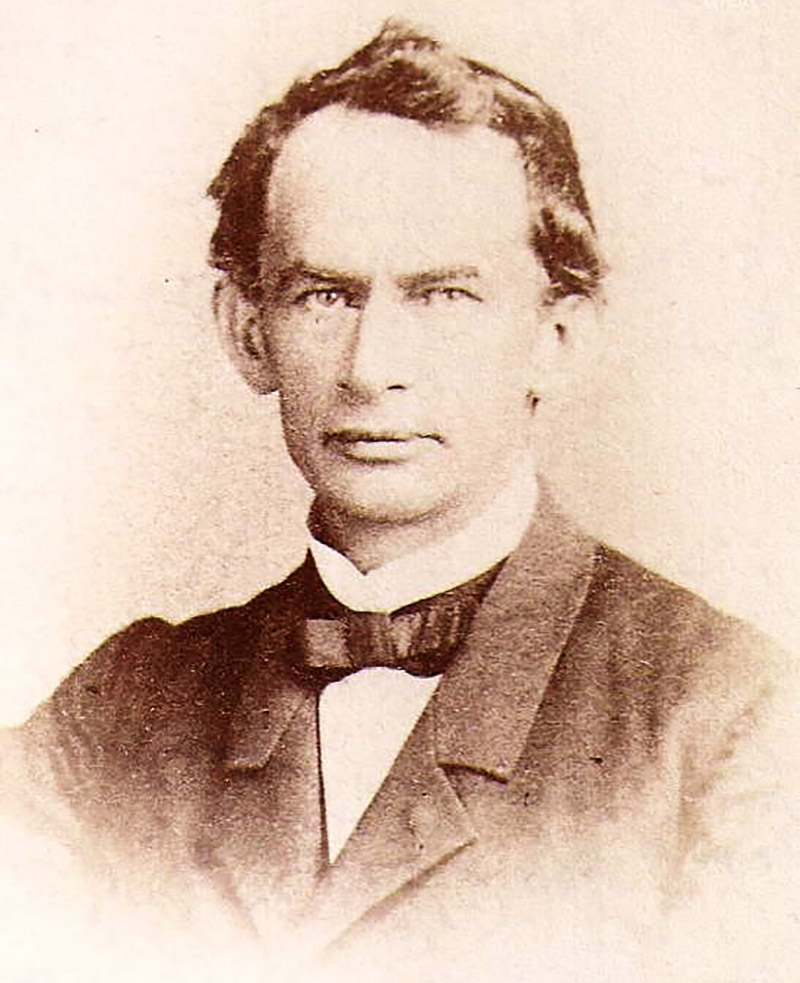
Figure 4.
Jacob Binder as a young man. Adapted for nonprofit, educational purposes from https://www.ancestry.co.uk/family-tree/person/tree/14890373/person/1005269599.
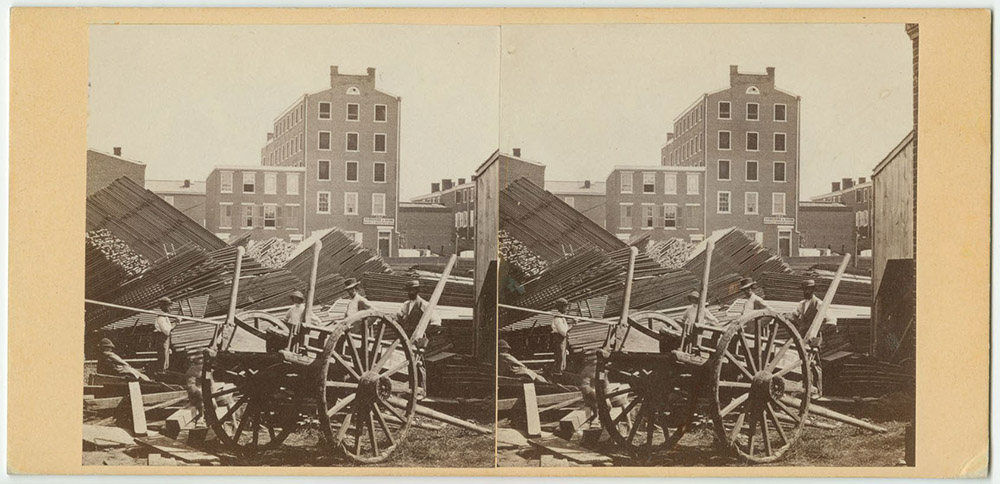
Figure 5.
A stereoview photograph of the wrecked lumber yard of Jacob and George A. Binder, Philadelphia, after the flood of September, 1861. Photographed by J. Moran, Philadelphia. Adapted for nonprofit, educational purposes from https://digital.librarycompany.org/islandora/object/digitool%3A100634.
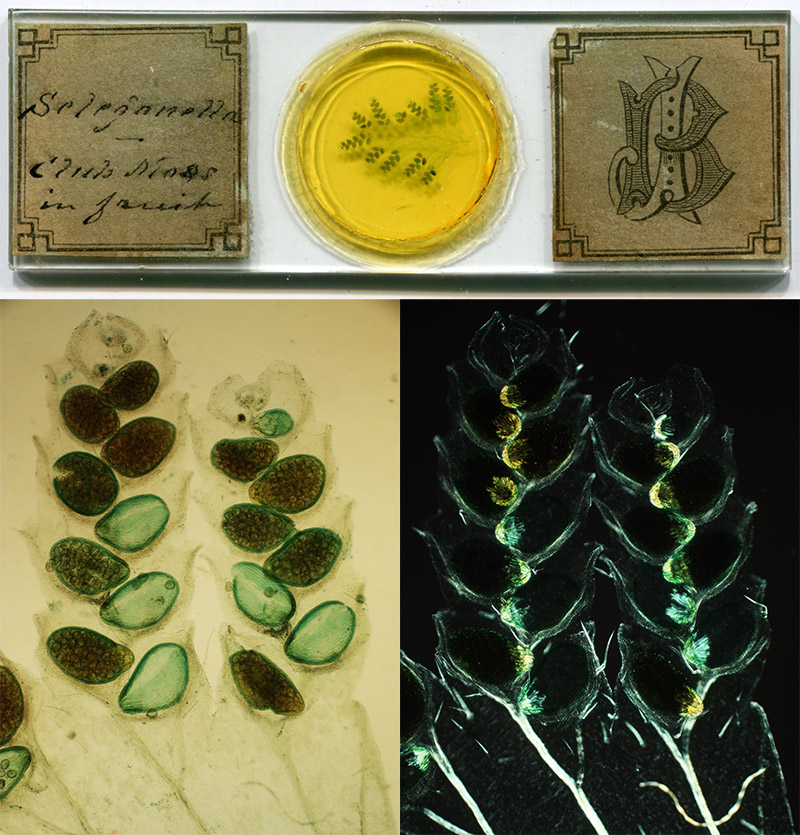
Figure 6.
"Seleganella - club moss in fruit", mounted ca. 1880s by Jacob Binder (see Figure 1). The currently accepted name of the genus is Selaginella. Photomicrographs produced with a C-mounted digital SLR camera and a 3.5x objective lens, using bright field (left) and crossed polarizing filters (right).
Resources
The American Monthly Microscopical Journal (1882) Report on the May 1 meeting of the Microscopical Section of the Academy Of Natural Sciences, Vol. 3, pages 138-139.
Annual Report of the Academy of Natural Sciences of Philadelphia (1892) page 487
Genealogy of Jacob Binder (accessed March, 2018) https://www.ancestry.co.uk/family-tree/person/tree/14890373/person/1005269599
Nolan, Edward J. (1909) A Short History of the Academy of Natural Sciences of Philadelphia, The Academy of Natural Sciences, Philadelphia, pages 25-26
Philadelphia City Directory (1861) “Binder, Jacob, lumber dealer and builder, SE 6th & Oxford, h 922 Marshall”, and “Binder, J. & G.A. (Jacob & George A. Binder), lumber yard SE c 6th & Oxford; moulding mill 6th n Oxford”, page 68
Proceedings of the Academy of Natural Sciences of Philadelphia (1879) Report of the Biological and Microscopical Section, Vol. 31, pages 444-445
Proceedings of the Academy of Natural Sciences of Philadelphia (1893) Vol. 45, pages 66-67 and 553
Proceedings of the Mineralogical and Geological Section of the Academy of Natural Sciences of Philadelphia (1877-1879) List of officers
Scientific American (1880) Report on the annual meeting of the Biological and Microscopical Section of the Academy of Natural Sciences of Philadelphia, Vol. 9, supplement, pages 3380-3381
US census and other records, accessed through ancestry.com





